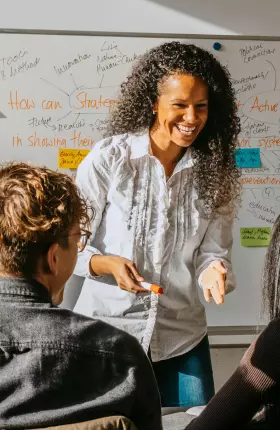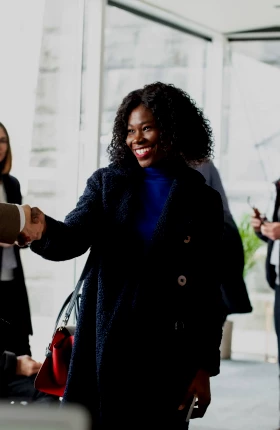Headlines about the financial health of higher education today are ubiquitous—plans to close, missing bond payments, deteriorating credit ratings, government scrutiny into student outcomes. With enrollment falling, many US higher-ed institutions—aside from elite, selective, deep-pocketed universities, whose attraction has only grown—are struggling to make ends meet. And with a “demographic cliff” of college-age students looming, the situation shows no signs of abating.
There is still hope, but institutions must move proactively—not wait to be enmeshed in a full-blown public crisis. To survive and thrive in today’s environment, resilient institutions will define a clear strategic vision and realign their entire institutions and the stakeholders around it, focusing on and investing in their true pillars of strength. They will achieve this vision by introducing a series of initiatives on the revenue side, such as launching in-demand degree programs, establishing employer partnerships, running targeted marketing and student recruitment, and fundraising. At the same time, they will identify cost efficiencies and, if necessary, spend down endowments and restructure their debt.
In addition, they will invest in fundamental enablers of long-term success: faculty and staff retention, a student-centered culture, and organizational agreement on accountability and performance.
In this article, we offer an overview of the issues at hand and a case study of a private higher-ed institution, the University of Tulsa (TU), that reversed its downward trajectory. Although the framework that TU leveraged in its turnaround is applicable for most institutions, the institution based its choices on its own specific needs and context, which may not be applicable to other schools in some respects.
A Path for Growth
Although it ranked as the top university in Oklahoma in 2017 and had been among the top 50 private universities in the country, TU more recently fell on tough times. First-time enrollment dropped 38% from fiscal year 2018–2019 to FY 2020–2021, and fiscal challenges were acute. Over the next two years, however, the institution developed and implemented a focused plan and gained buy-in from stakeholders. As a result, the university boosted first-time-student enrollment by 33%, increased net tuition revenue per student (NTR) by 16%, and reinstated previously discarded academic programs—all while increasing access and diversity on campus and taking better care of its faculty and staff.
Find a North Star. The first lesson that TU’s experience provides is that a higher-ed transformation should begin with understanding what the institution is growing toward—not what it is moving away from. Although administrators may be tempted to start by eliminating undersubscribed programs or reducing headcount, they should instead determine a North Star of focused institutional goals over the next five to ten years and a set of strategic opportunities. In this process it is essential to understand where the school has the “right to win”—that is, where its differentiating areas of strength lie—and to double down in those areas to improve its core value proposition. At TU, President Brad Carson noted that the school should “be best-in-class in a couple of things while being good enough in others—because you cannot be best-in-class in everything.” For instance, TU is one of three universities recognized by the US government as excelling in all aspects of cybersecurity, so that topic was a natural area of increased focus for the school. Likewise, since the school was already renowned for its world-class petrochemical engineering program, pivoting to adjacencies in renewable energy sources was a sensible choice.
Align stakeholders. School leaders should do serious groundwork to assure stakeholders—including the rest of the administration team, board, faculty, and donors—that they have a clear idea of the right direction to take. When Brad Carson joined TU in the summer of 2021, he considered inspiring confidence across faculty, administration, and staff to be one of his most important jobs as president. He focused on “getting the school’s swagger back” and articulated a bold vision for a 1,000-strong freshman class—a sharp reversal at a time when recent freshman classes had dwindled to just over 500, down from the university’s historical highs of over 900. He also announced that TU would become an R1 institution, designated by the Carnegie Classifications as the most research-intensive institutions, and a top 75 school, both of which represented significant leaps from its R2 status and 136 ranking by US News & World Report.
"Often, nonprofit higher-education institutions operate with no real goal in mind other than their own continued existence,” Carson noted. “When I set out to reach these ambitious—yet achievable—goals by 2027, that let people know where we are trying to go versus more abstract guidance to ‘be better.’ This clarity of vision allows our community of faculty and staff to focus their efforts on those targets."
Determine the role of the humanities. Choosing between a preprofessional focus and a humanities focus is a false dichotomy. The choice should be “both/and,” not “either/or,” with classes in the humanities complementing the university’s core pillars of strength. Technical skills are key to obtaining a great first job in a growing industry that offers a potential career direction, while critical thinking and durable soft skills honed by the humanities will enable graduates to rise in their careers.
At TU, some stakeholders who said that they no longer believed in the institution asserted that the school had forgotten the humanities. The school responded by reinstating some programs that had been cut and streamlining its curriculum so that students could take classes in those fields while earning preprofessional degrees in a new TU Scholars program. It also reinstated some previously eliminated majors, such as philosophy and music.
“The reason to come to TU is that you can be both a mechanical engineer and a musician, which is not possible at most schools,” said Carson. “This pairing is highly attractive to students, especially in Gen Z, who fear a lack of career applications but have a love for liberal arts exploration.” It took a year for administrators to adjust the curriculum, but when the university offered the Scholars program, students immediately enrolled. Within its first six months, the program attracted 23 participants, and the numbers continue to grow.
Work with industry. A powerful step toward strengthening a school’s preprofessional focus and helping students land their first jobs is to bring in industry as an essential partner, something that visionary universities are doing on several fronts. Such partnerships allow educational institutions to demonstrate a return on investment to many different audiences. For example, having industry partners can enable a university to expand programs designed to provide skills that are likely to meet future demand. It can also offer students applied training, such as internships, and give corporate employees the opportunity to improve their credentials through university certificate programs.
In the field of cybersecurity, TU has already seen positive results from industry partnerships that it has established in the past two years, including talent and research partnerships with Thales, CISO Global, and Rivian, as well as from an expansion of existing partnerships with US federal agencies.
Price to fit the value proposition. Every nonselective institution must determine how to increase its net tuition revenue. Yet most face heavy pressure to deepen tuition discounts in order to boost enrollment. These deep discounts often reflect a failure by the institution to understand its value and market, which leads it to set sticker prices so high that they deter some students and families from applying.
As part of their new vision, therefore, schools should reassess their pricing strategy. Most schools today use a standard stairstep matrix that looks at a combination of a student’s need and merit to determine financial aid and tuition discounts. This matrix frequently results in funding for students who do not need it, even as outstanding students who cannot afford to pay receive too little. Instead, schools should more precisely target the discounts they offer and more effectively communicate their value proposition to the students they want. In particular, they should work to align student discounts with outcomes.
“We changed our financial aid allocation approach from offering deep discounts for all students to focusing more financial aid resources on truly top academic applicants and those with significant needs,” says Carson. “To help, we used machine learning algorithms to model and optimize yields instead of the standard stairstep matrix.” In just two admissions cycles, this approach allowed TU not only to raise enrollment by 33% but also to reduce its discount rate by 4 percentage points (pp), resulting in increased NTR of $2,000 per student.
Perhaps most important, TU achieved these financial gains in tandem with advancing its access mission, as it also saw a 12-pp increase in the percentage of new students receiving Pell grants and a 6-pp increase in the racial diversity of new students. Simultaneously, TU invested in improving wraparound student support services, one element of which was that the president shared his own cell phone number with students to ensure that he received direct feedback from them on their experience.
Boost marketing and admissions. Many schools fail to focus their student recruitment efforts on the regions and high schools best suited to their offerings, instead spreading out already thin resources. By directing these efforts, to the extent possible, on regions and high schools with some combination of a healthy awareness of the institution, significant prior student enrollment, and a sufficient population, a university can boost its enrollment, cultivate connections, and increase yield (the percentage of accepted students who actually enroll).
Schools should also ensure that they properly staff their marketing and admissions departments and hold them accountable for effective recruitment. And to deploy their marketing budget as effectively as possible, they should use digital tools to connect with students through the most appropriate channels.
Concurrently with changing its financial aid allocations and value proposition, TU focused on improving its brand. Carson explains, “We doubled our marketing and admissions budgets, hiring four admissions officers to recruit in focal geographies; got more university leaders, including myself, involved; and held ourselves accountable to weekly metrics for applications started and finished.” In addition, TU committed to improving student outcomes by providing a job placement guarantee that offers free tuition for the first semester in one of TU’s master’s degree programs to any student who cannot find a high-quality job or enroll in graduate school within six months of graduation.
These investments caused the number of applicants to TU to double in a single year (from the 2021–2022 admission cycle to the 2022–2023 cycle), encouraging the university to halve its acceptance rate in the 2022–2023 cycle (to 37%). The success of these efforts generated positive reinforcement through earned media coverage, especially in the local press, where TU enjoyed a recast image as a stronger university whose problems were behind it. The school’s freshman class for the 2022–2023 year grew to 770 students.
Stay ahead with BCG insights on education
Funding the Journey
After setting the vision and aligning on the new way forward, institutions must find ways to fund the journey, both for the immediate future and over the longer term. Many are already struggling financially to fund their day-to-day operations.
Fund financial gaps with development. An institution dedicated to successfully transforming itself will likely need to raise additional funds just to dig out of its current deficit. Gaining annual and endowment pledges in support of the new strategy is especially important. TU launched a development campaign that raised $40 million in bridge funding to cover the early deficit years, to endow programs such as athletics that needed to be self-sustaining rather than subsidized by the educational mission, and to fund growth initiatives to avoid further erosion of the endowment fund.
Seek to break even on athletics. A school’s athletics program often means a great deal to its stakeholders, reflecting their pride in the institution, and it can be a tremendous rallying cry for alumni. Nevertheless, the academic side of the school should not subsidize the athletic program. Instead—given that very few institutions run a surplus in athletics—the goal should be to break even. At TU, for example, coaches are required to “own” their team’s P&L and ensure that they do not generate an operating loss. In addition, schools should reach out to donors in a transparent way to ask that they help the athletics program run sustainably.
Another critical strategy for helping athletics achieve breakeven status as a department (with the additional benefit of helping improve a school’s NTR) is to attract athletes in non-revenue-producing sports, such as golf and tennis, as well as in cheerleading and marching band, from wealthier families whose children are eager to pursue their athletic passions in college and are willing to pay more to do so. At TU, such students are classified as walk-ons (as opposed to scholarship athletes), although a coach evaluates them in advance and tells them whether they will have the opportunity to play. In the university’s first year of implementing this approach, 52 students joined TU teams as walk-ons.
Minimize friction over cost and staff reductions. In several areas, schools can pursue cost-cutting measures without lasting detriment to the school, if they handle the task well. Because of faculty handbook and tenure protections, reducing faculty is very difficult in the short term. A better approach is to make targeted, compelling offers for voluntary retirement. Naturally, schools must devise such offers carefully to avoid demotivating the remaining faculty members or losing some of the most productive ones. They may also reduce administrative and operations staff positions through more limited severance, and they should examine procurement for possible cost cutting, if the school has high spending in that area.
At TU, Carson sees operating efficiency and effectiveness as a strategic advantage and says that his mantra is “no financial margin, no mission.” At the start of the transition, he set a goal of reducing operating expenses by 6% over three years, with a particular focus on not refilling vacated staff positions. He now notes, “Perhaps the most important outcome of this exercise was the financial awareness and accountability for the efficient use of funds that became ingrained throughout the organization.”
Regardless of what they cut, institutions need to communicate their actions clearly to all stakeholders, explaining both the crisis they are addressing and their vision for the future. In particular, they should emphasize the point that they are cutting funds in order to reinvest them in the future of the school.
Raise short-term cash through endowment draws and asset sales. Many schools have made unsustainably high discretionary endowment withdrawals over the years to cover operating deficits, and they will have to take even more for bridge funding when the transformation begins. To justify these new withdrawals, university leaders must convince the board and other stakeholders that they have a clear plan to stop the hemorrhaging of funds in the future. They must also convince donors that the school has developed a clear and compelling business plan that the board, faculty, and administration have rallied behind.
Selling off nonessential assets such as real estate holdings is a significant way to raise cash, but administrators must check carefully to ensure that no donor restrictions on the properties prevent their sale. TU, for example, sold $3 million worth of nonstrategic assets in 2023.
Explore debt restructuring. Another option is to go to the school’s creditors and perform the delicate dance of debt restructuring—renegotiating existing debt to push out due dates, potentially at higher interest rates. Many creditors with local presence will not want the school to close, given its economic importance to the community and will therefore be willing to talk.
Organizing for Sustained Performance
Creating a vision and raising funds to avert the crisis, although essential, are not enough in and of themselves. Institutions must also reorganize for sustained performance if they are to support the transformation over the long term. We recommend that schools take three critical steps.
Ensure deep board involvement. The board will play a key role in any successful transformation, working proactively and in close partnership with the president of the university. Board members must ask tough but necessary questions, join faculty meetings to reassure faculty members that the board is doing its fiduciary duty, and keep everyone focused on the envisioned outcomes. They must make also difficult financial decisions if the school is to raise enough funding to support the transition.
Marcia MacLeod, TU’s board chair, notes that the university got into trouble in the first place partly because the board was too little involved prior to the downturn, and in the second place because, once the problems were uncovered, it began setting unreasonable target dates for achieving financial breakeven, without making the difficult choices needed to achieve it. Ultimately, she says, “We realized we could not cut our way to prosperity; we needed to define a North Star to help navigate out of the financial issues.” Not only was TU’s board deeply involved in the development of the strategic plan and the resulting initiatives, but also it established clear accountability with staff and faculty, creating an ad hoc strategy committee and closely monitoring the progress through biweekly meetings.
Establish a transformation management office. We recommend establishing a transformation management office (TMO) composed of two to four board members and administrators who can tackle issues together and move the transition forward. The TMO’s primary role is to keep everyone progressing on task, as normal processes within a university tend to move relatively slowly. In addition, the TMO should help create a “culture of performance and execution,” develop clear metrics and milestones for success, and ultimately be accountable to the board and other stakeholders.
Setting up the TMO will mean pairing a dedicated project manager from within the university, often an administrator, with a board member and, for some meetings, with the president as well. TMO metrics and milestones may include enrollment and tuition, retention rates, contributions and endowment, research quality, social media mentions, and program excellence, among other topics, and should be used to manage and motivate stakeholders and staff.
To determine the right program metrics at TU, which was a contentious issue, President Carson presented the board with program reviews for the top 100 US universities and adopted the metrics used in those reviews. The faculty agreed to an academic review committee based on those best practices. By using objective standards, Carson convinced stakeholders that the school was not trying to game the system and made it hard for faculty members to argue that the metrics were unfair.
Taking care of the faculty is an important aspect of delivering TU’s new value proposition, so the school introduced a bonus culture for faculty who improve their metrics. Simultaneously, the university has reinstated its retirement plan, and money saved through attrition at the staff level is now frequently redeployed to hiring new faculty.
Engage the full breadth of stakeholders. A university has many important stakeholders, as any group—faculty, staff, donors, alumni, or students—can bring the transformation to a halt if it does not feel heard. MacLeod points out, “It is more than just defining and driving to the North Star. It is also having tough conversations with faculty, administrators, and other board members, to help them see value in the transformation journey and lock arms together.”
These conversations have paid off at TU, instilling trust and leading to a new generation of administrative leadership rising from faculty ranks, including the current vice provost and the leader of the TMO, who successfully navigated organizational needs while working effectively with those on the front lines to execute the plans.
Schools often fail to provide stakeholders with insight into their own impact, such as revealing to faculty members the financial performance of their department or communicating to stakeholders—including faculty and staff—the need to teach or recruit more students. To improve faculty and staff engagement and to create accountability, institutions must provide information in advance and allow stakeholders to respond. As President Carson notes, “We have to be radically transparent. We have to tell people the hard truth in an empathetic way, even if they don’t want to hear it.” Carson holds open meetings with faculty and staff, tells them exactly how he sees the university’s financial situation, refuses to play political games, and genuinely embraces feedback. Doing so has further increased trust among faculty and staff and smoothed relationships.
Rather than undertaking an arduous transformation journey at a time of institutional distress, some boards and leadership may wish to explore M&A, entity restructuring, or the threat of closure. But such moves tend to be highly complex, and the outcomes are uncertain until the final throes, so schools should proceed down those roads with caution. In many cases, the hard work of transformation is the most viable way forward.





